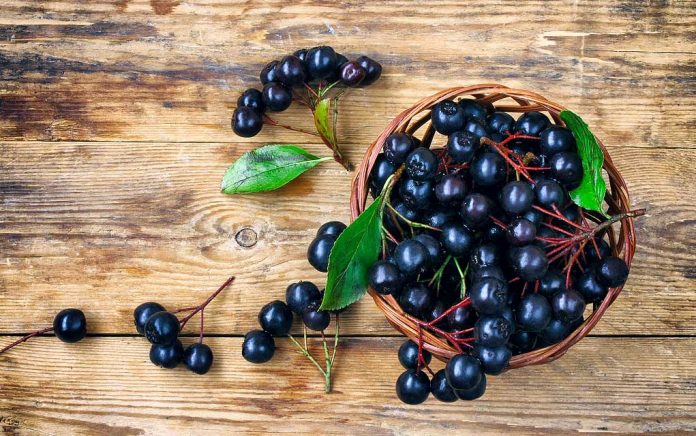
For those of you who are scratching your head wondering what aronia berries are, here’s the quick skinny: They have been around for a while (although not appreciated completely) under their more common name-chokeberries. With a name like that, you can understand why people might be reluctant to line up for these tasty morsels. Now, however, they are gaining recognition as a new superfood.
According to Ken Sailors, a US grower and expert on aronia berries, he changed the name from chokeberries to aronia berries because “Why use the word choke in your name?” People seem to agree. “Almost every manufacturer and grower and news media have shifted now to the name aronia,” he said.
Skinny on Aronia Berries
Aronia berries are the fruit of a deciduous shrub that is native to eastern United States and Canada, and especially in swamps and wet wooded areas. Since the early 20th century, the berries have been cultivated in eastern Europe and Russia, where they are popular in wine and juices. The berries are now being planted in Iowa and other upper Midwestern states as their popularity grows.
Read more about reasons to eat berries
Of the three species (A. arbutifolia, A. melanocarpa, and A. prunifolia), the black variety (A. melanocarpa) is the one most often used fresh, dried, as a juice, concentrate, and powder. It is also the species that has the highest antioxidant content. Because these little black berries have significant pucker power (due to their astringency, not the desire to kiss!), some people prefer to enjoy them in jams, salsa, ice cream, syrup, juice, wine, teas, and even baby food!
Antioxidant Power
The superfood status assigned to these little black berries comes from its impressive ORAC (Oxygen Radical Absorbance Capacity) value. Aronia berries surpass açai berries, blueberries, raspberries, goji berries, cranberries, and other fruits in ORAC values. ORAC is a method that measures the antioxidant capacities of foods. Generally, experts believe that the higher the ORAC value of foods, the better is their ability to provide health benefits and help lower the risks of aging, cancer, and other diseases.
Read more about other superfoods
Before the US Department of Agriculture (USDA) removed the ORAC Database for Selected Foods from its website (see Note below), raw chokeberries were assigned an ORAC of 16,062. The USDA recommends individuals consume about 3,000 to 5,000 ORAC units daily.
How Many Aronia Berries Should I Eat?
How many aronia berries would you need to eat to meet or (even better!) beat this recommendation? According to Silvio Mattacchione, a grower and researcher of aronia berries as well as the Canadian importer of Superberries (an aronia berry concentrate), most scientists believe 30 berries per day will deliver about 7,400 ORAC. For those who cannot find aronia berries or who want to reap the health benefits in another form, then various aronia berry products such as powders, concentrates, and capsules are available.
The antioxidant properties of aronia berries are attributed to the presence of polyphenols, including the categories proanthocyanins and anthocyanins. Among the many potent antioxidants in aronia berries are tannins, caffeic acid, catechins, quercetin, rutin, hesperidin, and procyanidin.
[Note: The USDA removed the ORAC database because, “ORAC values are routinely misused by food and dietary supplement manufacturing companies to promote their products and by consumers to guide their food and dietary supplement choices,” and “the values indicating antioxidant capacity have no relevance to the effects of specific bioactive compounds, including polyphenols on human health.” Not everyone agrees with these reasons, but if you look for the ORAC database online, you no longer will be able to find it.]
Health Benefits of Aronia Berries
What are some of the health benefits of aronia berries? Here are a few of the findings from the research.
- Urinary tract infections. A recent study evaluated the use of aronia berry juice in dealing with urinary tract infections among nursing home residents, who are very susceptible to such infections. The researchers found that a mere 3 to 5 ounces of aronia berry juice consumed daily for three months was associated with a 38 percent to 55 percent reduction in the incidence of urinary tract infections.
- Immune function. In a recent study published in Food Chemistry, aronia berries were compared with rosehip, hawthorn, blackcurrant, blueberry, and rowanberry for their antioxidant and antimicrobial abilities against 11 human pathogens. Although all of the berries inhibited the production of reactive oxygen species (ROS), aronia berry extracts (as well as blackcurrant and rowanberry) showed strong antimicrobial properties against a wide range of microorganisms. ROS are a type of free radical that contains oxygen. Free radicals are unstable molecules with an unpaired electron that damage cells and tissues and are associated with disease.
- Cellulite. Do you have cellulite? Well, aronia berries might come to your rescue. In the Journal of Medicinal Food, researchers reported how 29 women with cellulite responded to 100 mL (about 3.5 oz) of organic aronia berry juice daily for 90 days. All the women had their skin structure analyzed by ultrasonography for the thickness of subcutaneous tissue. The women experienced an average reduction in subcutaneous tissue thickness of 1.9 millimeters and an average decline in the length of subcutaneous tissue fascicles (muscle fibers) of 1.18 millimeters. After taking aronia berry juice for 45 days, edema declined by 55.2 percent. By the end of the 90-day period, none of the women had edema. The bottom line was that aronia berry juice “could have beneficial effects on the cellulite condition.”
- Flu fighter. In mouse models, use of Aronia melanocarpa protected the animals from lethal challenges of the flu virus. The authors of the research say that two constituents found in the berries-ellagic acid and myricetin-“have potential as influenza therapeutics.”
- Cholesterol and blood pressure. Several studies have looked at the impact of aronia berry extract on two factors closely linked to heart disease: high cholesterol and high blood pressure. Research in mice indicates that aronia berry extract can lower total cholesterol levels while a rat study suggested that the extract could help bring down blood pressure.
Aronia berry products are gradually making their way to supermarkets and health food stores around North America, and you also can get them online. If you are looking for a new way to get more free-radical bashing antioxidants into your life, then aronia berries may be the new superfood in your life!
Read next:
Eat Some Now: 5 Benefits of Strawberries
11 Benefits of Blueberries; Backed by Science (and 3 Delicious Blueberry Recipes)
Should You Go for Goji Berries?










